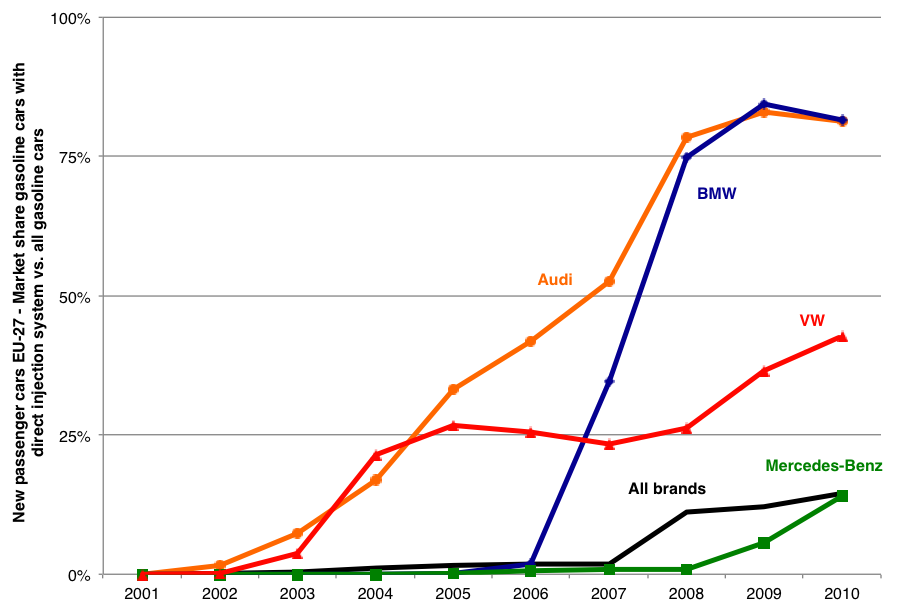Blog
Vehicle tech notes: Making combustion more efficient
One of the striking features of the European vehicle market over the last decade is the sharp increase in market share of passenger cars using gasoline direct injection (GDI). This trend (see the figure below, from the ICCT’s European Vehicle Market Statistics) has everything to do with manufacturers looking for greater vehicle efficiency and lower CO2 emissions. It neatly illustrates both how ambitious regulatory targets drive technological decisions in constructive directions and what kinds of trade-offs we need to be alert to.
 In conventional gasoline engines, fuel and air are mixed in the intake tract before entering the combustion chamber. GDI vehicles, in contrast, inject highly pressurized fuel directly into the combustion chamber. In addition to more precise fuel control, this offers two substantive advantages. The first is charge air cooling. Fuel is injected into the combustion chamber after air has been drawn in through the intake valves. As the fuel evaporates it cools the air/fuel mixture, which reduces engine knock and allows higher compression ratios and higher charge densities. This is especially important when combined with turbochargers, as the charge air-cooling helps offset the higher combustion temperatures.
In conventional gasoline engines, fuel and air are mixed in the intake tract before entering the combustion chamber. GDI vehicles, in contrast, inject highly pressurized fuel directly into the combustion chamber. In addition to more precise fuel control, this offers two substantive advantages. The first is charge air cooling. Fuel is injected into the combustion chamber after air has been drawn in through the intake valves. As the fuel evaporates it cools the air/fuel mixture, which reduces engine knock and allows higher compression ratios and higher charge densities. This is especially important when combined with turbochargers, as the charge air-cooling helps offset the higher combustion temperatures.
The second advantage is that if the GDI system is combined with variable valve timing, then the intake valves can be opened for a longer period at low engine RPM to improve exhaust scavenging and increase the amount of intake air. In a conventional engine, with premixed air/fuel mixtures, leaving the exhaust valves open longer and opening the intake valves earlier would cause fuel to go out the exhaust unburned. But with GDI, fuel injection can be delayed until the exhaust valves have closed, resulting in higher torque and more operation at low engine speeds. In modern systems it is even possible to run the engine in different modes, depending on the load: Stratified charge surrounded mostly by air during light-load running conditions for higher efficiency; stoichiometric, homogeneous charge during moderate and heavy-load running conditions for reduced emissions.
Combining GDI with downsizing of the engine (through turbocharging) and dual-cam phasing can increase vehicle efficiency and reduce CO2 emissions by 15%. Note that this estimate does not include the potential benefit from using stratified charge operation during light-load operation. However, here’s the tradeoff: GDI vehicles tend to emit more particulate matter than conventional gasoline vehicles. Applying a particulate filter might therefore become necessary for GDI vehicles (see this ICCT working paper).
The chart shows market share of GDI passenger cars in the European Union (EU-27) from 2001 until 2010. The underlying data was compiled by ICCT making use of registration/sales statistics from R. L. Polk as well as technical data from Automobil Revue magazine and vehicle manufacturers directly.
Overall market share of GDI vehicles is estimated at around 15% in 2010, having increased sharply beginning in 2008. For an accurate comparison of the data it should be noted that many of the early (Audi and VW) GDI vehicles limited operation to only homogeneous charge, whereas more complex designs introduced later also allow for stratified charge, with greater efficiency and more CO2 reduction benefit.
